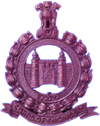| Indian Army Corps of Engineers | |
|---|---|
 The logo of the Corps of Engineers | |
| Active | 1780- Present |
| Country | |
| Branch | |
| Garrison/HQ | New Delhi, India |
| Motto(s) | Sarvatra (Ubique, Everywhere) |
| Colors | Maroon and blue |
| Engagements | First Anglo-Afghan War Second Anglo-Afghan War First World War Second World War Burma Campaign Sino-Indian War Indo-Pak War-1947 Indo-Pak War-1965 Indo-Pak War-1971 Kargil War |
| Commanders | |
| Engineer-in-Chief | Lt Gen Arvind Walia[1] |
| Insignia | |
| Regimental flag |  |
The Indian Army Corps of Engineers is a combat support arm which provides combat engineering support, develops infrastructure for armed forces and other defence organisations and maintains connectivity along the borders, besides helping the civil authorities during natural disasters.[2] College of Military Engineering, Pune (CME) is the premier technical and tactical training institution of the Indian Army Corps of Engineers.
The Corps consists of three groups of combat engineers, namely the Madras Sappers, the Bengal Sappers and the Bombay Sappers.
It has a long history dating back to the mid-18th century. The earliest existing subunit of the Corps (18 Field Company) dates back to 1777 while the Corps officially recognises its birth as 1780 when the senior-most group of the Corps, the Madras Sappers were raised. A group is roughly analogous to a brigade of the Indian infantry, each group consisting of a number of engineer regiments. The engineer regiment is the basic combat engineer unit, analogous to an infantry battalion. Besides the combat engineers, the Corps mans and operates major engineering organisations such as the Military Engineer Services,[3] the Border Roads Organisation (BRO), the Married Accommodation Project and the Survey of India.[4]
- ^ "Gazette of India No 45" (PDF). 2020-11-07. Retrieved 2020-11-24.
- ^ "Indian Army Celebrates 240th Corps of Engineers Day". Press Information Bureau. Government of India- Ministry of Defence.
- ^ "MES official website".
- ^ Globalsecurity.org, Indian Corps of Engineers